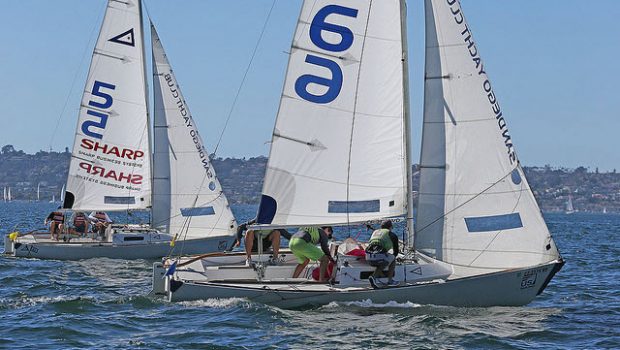Develop the game plan with a game plan
Published on January 4th, 2018
David Dellenbaugh’s Speed & Smarts newsletter is a bi-monthly newsletter packed with tips to improve our racing performance. In this report shared for the US Sailing Blog, Dave delivers a game plan to help develop your game plan.
When you’re trying to make a game plan for the start and first beat, it’s important to collect a lot of strategic information before the race. But you don’t have to do this alone.
The rules say a boat cannot receive outside help while she is racing. However, there is no rule against getting or giving help before your preparatory signal. In fact, working with one of your competitors may help both of you understand the wind and current better than either could do alone.
If you like the idea of having a “strategy buddy,” try approaching another sailor in your fleet before you head out to the course. Pick someone you think is friendly, smart and cooperative, and see if they’d be willing to work together on strategy before the start. Here are some things the two of you can do:
• Sail around the course area. I like to check out wind and current all around the course before the race, but sometimes there isn’t time to do this. If you have a strategy buddy, however, you can split the course in half. Each boat sails to their side of the course, and then both meet at the starting line to discuss what you learned about wind pressure, wind shifts, current strength and current direction.
• Tune up side by side. Two-boat testing is a great way to check out and improve your boat speed before a race. It’s also a perfect time to gather strategic information about the wind. When you have another boat right near you it’s easier to figure out what the wind is doing. By watching the relative performance of the boats, you will often get a feeling for which side of the course is favored.
• Split tacks upwind. Another way to figure out which side of the course is favored is to set up a ‘rabbit start’ with your buddy near the starting line. After the port tacker ducks behind the starboard tacker, the boats sail apart on opposite tacks for a pre-determined amount of time (e.g. for three minutes). Then both tack and sail toward each other until one boat crosses ahead. This will help you see which side of the course is favored. Of course, you have to take these test results with a grain of salt. If the wind is oscillating, for example, you may be seeing just one oscillation. If you did a split again, maybe the other side would have come out ahead. No matter what the wind conditions, remember they are likely to change at least a little between this test and the start.
• Check the starting line. Working with a buddy is a great way to determine which end of the line is ‘favored.’ Synchronize watches so you start at opposite ends of the line on opposite tacks at the same time. Then see which boat crosses in front of the other. This will tell you not only which end is farther upwind – it will also show you by how much that end is favored.
Don’t be afraid to talk and work with people on other boats before and in between races. If you are willing to share what you learn about the course with them, they will likely be the same way. And this could give both of you a strategic advantage over the rest of the fleet. As they say, two heads are usually better than one.
Source: US Sailing Blog










 We’ll keep your information safe.
We’ll keep your information safe.